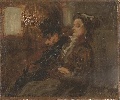Saturday, November 30, 2013 -  Anne-Marie O'Connor,Gurlitt art collection,Henri Matisse,Honoré Daumier,Max Libermann
Anne-Marie O'Connor,Gurlitt art collection,Henri Matisse,Honoré Daumier,Max Libermann
 No comments
No comments
 Anne-Marie O'Connor,Gurlitt art collection,Henri Matisse,Honoré Daumier,Max Libermann
Anne-Marie O'Connor,Gurlitt art collection,Henri Matisse,Honoré Daumier,Max Libermann
 No comments
No comments
Gurlitt Art Collection: "Europe's dirty little art secret", 252 Works of Art Disclosed and HARP adds perspective
 |
| Gurlitt Collection: Daumier's Don Quixote and Sancho Panza |
The outrage sparked by the clumsy handling of a Nazi-looted art trove in Munich, which was revealed this month, shows the urgent need for transparency in the art world, from museums to auction houses to private collections. For years this rarefied world has functioned like a private club. Many institutions, especially in Europe, have kept their World War II-era provenance files discreetly locked away, or have even quietly accepted questionable art from moneyed donors. Dealers too have looked the other way — until a painting stolen during the Holocaust is suddenly, fortuitously spotted, and an auction block turns into a crime scene. The Munich artworks — many of which were apparently either confiscated from Jewish families, bought for a fraction of their value or pulled off museum walls as "degenerate art" — are only the latest glaring example of the need for openness.
[...]
The truth is this: Any work coming up for auction, offered in donation or held in state or private collections that has gaps or shifts in its ownership between 1933 and 1948 might have been stolen or obtained under duress. The records relating to such works must be made easily available, and the job of sorting through the documentation should be left to professionals who specialize in tracing Nazi art theft — and to the claimants themselves.
The Central Registry of Information on Looted Cultural Property 1933-1945 issues a weekly newsletter lootedart.com. This week the headlines include "252 Works of Art from the Gurlitt Collection Disclosed to Date":
The Central Registry's list of the Gurlitt Works consists of many drawings, watercolors, prints, and lithographs by artists such as François Boucher, Canaletto, Cézanne, Marc Chagall, Corot, Daumier, Degas, Delacroix, André Derain, Otto Dix, Dürer, Ingres, Max Liebermann, Manet, Millet, Munch, Picasso, Pissarro, Rodin, Rousseau, Seurat, Tiepolo, and Toulouse-Lautrec. Three oil paintings are listed: Don Quixote and Sancho Panza by Honoré Daumier; Riders on the beach by Max Liebermann (Provenance: Collection David Friedmann, Breslau); and Seated Woman in an Armchair by Henri Matisse (Provenance: Collection Paul Rosenberg, Paris; 1944 purchased from Gustav Rochlitz).
In the German DW.DE, journalist Jefferson Chase interviews HARP for a perspective in "Gurlitt case takes Allies, global art market to task": Parts of the Gurlitt collection are likely of dubious provenance. But why were they restored at all to an art dealer who had worked for the Nazis? DW asked two founders of the Holocaust Art Restitution Project: One side to the story that has largely escaped scrutiny, however, is the role of Allied occupation authorities after World War II. After all, they were nominally responsible for ensuring that art looted by the Nazis was returned to its proper owners in the first place. Rightly or wrongly, the state prosecutor in the city of Augsburg has come under criticism for the length of time between the seizure, which was only made public by a German news magazine at the start of this month, and initial attempts to restore the artworks to their legitimate owners. But questions should also be asked as to how Germany's post-war occupiers could have allowed Hildebrand Gurlitt - one of the leading art dealers in the Third Reich - to amass a collection including works by Chagall, Matisse, Picasso, and Dix and then pass that trove on to his son Cornelius. US soldiers had the tough task of finding the proper owners of looted art.
According to historian Marc J. Masurovsky, another co-founder of HARP, Hildebrand Gurlitt was an established art dealer and a former museum director "who was given significant responsibilities during the 12-year reign of the National Socialists both to recycle thousands of so-called 'degenerate' works purged by decree from German public collections and to acquire untold numbers of works and objects of art at auctions inside the Reich and from galleries, dealers, collectors and artists living and working in German-occupied territories." |





